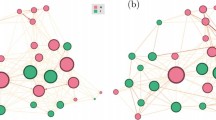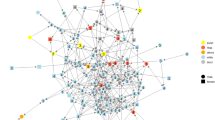Abstract
This article deals with the analysis of homophily and heterophily in ego-centred networks (personal networks). The analysis takes a dual approach. First it uses the classical definition of homophily (in this article called elementary homophily) to compare mutual ties between groups defined by employment status, age and city of residence. These analyses are then enriched by incorporating the level of affective proximity, thus forming what we have called specific homophily. The analysis of elementary homophily confirms the expected predominance of homophilous relationships over heterophilous ones. The analysis of specific homophily shows that inter-group relationships between close and intimate contacts follow similar patterns, whereas these differ substantially for relationships that are not at all close. The comparison of the two types of homophily shows a correspondence between high values in elementary homophily and high values in close and intimate relationships.




Similar content being viewed by others
Notes
These data come from the project CASREDIN (comparative case study of cases on the mutual influence between capital and social inclusion and integration, stability, development and qualification in employment). See the acknowledgments section.
It would be possible to extend the study to heterophilic relationships but this lies beyond the scope of this article.
References
Aldrich, H.E., Elam, A., Reese, P.R.: Strong ties, weak ties and strangers: Do women business owners differ from men in their use of networking to obtain assistance? In: Birley, S., MacMillan, I. (eds.) Entrepreneurship in a Global Context, pp. 1–25. Routledge, London (1996)
Allan, G.A.: A Sociology of Friendship and Kinship. G. Allen & Unwin, London (1979)
Bidart, C.: L’amitié, les amis, leur histoire. Représentations et récits. Sociétés Contemporaines 5, 21–42 (1991)
Burt, R.S.: Structural holes versus network closure as social capital. In: Lin, N., Cook, K., Burt, R.S. (eds.) Social Capital: Theory and Research, pp. 31–56. Aldine de Gruyter, New York (2001)
Burt, R.S.: Structural holes: The social structure of competition. Harvard University Press, Cambridge (1992)
Burt, R.S.: The gender of social capital. Ration. Soc. 10, 5–47 (1998)
Burt, R.S.: The network structure of social capital. Res. Organ. Behav. 22, 345–423 (2000)
Campbell, K.E.: Gender differences in job-related networks. Work Occup. 15, 179–200 (1988)
Coenen-Hunther, : Relations d’amitié, mobilité spatiale et mobilité sociale. Espaces et Sociétés 54—-55, 50–65 (1989)
Cohen, J.: Sources of peer group homogeneity. Sociol. Educ. 50(4), 227–241 (1977)
Davis, K.E., Todd, M.J.: Friendship and love relationships. In: Davis, K.E. (ed.) Advances in Descriptive Psychology, pp. 79–122. JAI Press, Greenwich (1982)
Duncan, O.D., Featherman, D.L., Duncan, B.: Sociometric Background and Achievement. Seminar, New York (1972)
Eisenstadt, S.N., Roniger, L.: Patrons, Clients and Friends; Interpersonal Relations and the Structure of Trust in Society. Cambridge University Press, Cambridge (1984)
Feld, S.: The focused organization of social ties. Am. J. Sociol. 86(5), 1015–1035 (1981)
Ferrand, A.: Amis et associés. CESOL, Fasc. 1, 2, 6 (1985–1986).
Ferrand, A.: Connaissances passagères et vieux amis, les durées de vie des relations interpersonnelles. Revue Suisse de Sociologie 2, 431–439 (1989)
Ferrand, A.: L’inverse de l’ordre; essai d’interprétation d’un type d’amitié., n.p., LASMAS-CNRS (1990).
Festinger, L.: A Theory of Cognitive Dissonance. Stanford University Press, Stanford (1957)
Fischer, C.S.: To Dwell Among Friends: Personal Networks in Town and City. University of Chicago Press, Chicago (1982)
Granovetter, M.S.: The strength of weak ties. Am. J. Sociol. 78(6), 1360–1380 (1973)
Hamm, J.V.: Do birds of a feather flock together? Individual, contextual, and relationship bases for African American, Asian American, and European American Adolescents’ selection of similar friends. Dev. Psychol. 36(2), 209–219 (2000)
Ibarra, H.: Race, opportunity, and diversity of social circles in managerial networks. Acad. Manag. J. 38(3), 673–703 (1995)
Ibarra, H., Andrews, S.B.: Power, social influence, and sense making: Effects of network centrality and proximity on employee perceptions. Adm. Sci. Quart. 38(2), 277–303 (1993)
Kalmijn, M.: Intermarriage and homogamy: Causes, patterns and trends. Annu. Rev. Sociol. 24, 395–421 (1998)
Kossinets, G., Watts, D.J.: Origins of homophily in an evolving social network. AJS 115(2), 405–450 (2009)
Laumann, E.O.: Bonds of Pluralism: The Form and Substance of Urban Social Networks. Wiley, New York (1973)
Lazarsfeld, P.F., Merton, R.K.: Friendship as a social process: A substantive and methodological analysis. In: Berger, M., Abel, T., Page, C.H. (eds.) Freedom and Control in Modern Society, pp. 18–66. Octagon Books, New York (1954)
Leenders, R.T.: Evolution of friendship and best friendship choices. Journal of Math. Sociology 21(1–2), 133–148 (1996)
Lin, N., Ensel, N., Vaughn, J.C.: Social resources and strength of ties: Structural factors in occupational status attainment. Am. Sociol. Rev. 46, 393–405 (1981a)
Lin, N., Ensel, W.M., Vaughn, J.C.: Social resources and occupational status attainment. Soc. Forces 59, 81–1163 (1981b)
Loomis, C.P.: Political and occupational cleavages in a Hanoverian village. Sociometry 9, 316–333 (1946)
Lott, A.J., Lott, B.E.: Group cohesiveness, communication level, and conformity. J. Abnorm. Soc. Psychol. 61, 408–412 (1961)
Lozares, C., Verd, J.M., López-Roldán, P., Martí, J., Molina, J.L.: Cohesión, Vinculación e Integración sociales en el marco del Capital social. REDES-Revista hispana para el análisis de redes sociales. 20 1. http://revista-redes.rediris.es (2011). Accessed 24 Oct 2012
Marsden, P.V.: Core discussion networks of Americans. Am. Sociol. Rev. 52, 122–313 (1987)
Mayhew, B. H., Mcpherson, J. M., Rotolo, T., Smith-Lovin, L., Carolina, S., McPherson, J. M.: Sex and race homogeneity in natural occurring groups. Soc. Forces 74(1), 15–52 (1995)
McPherson, J.M., Smith-Lovin, L., Cook, J.: Birds of a feather: Homophily in social networks. Annu. Rev. Sociol. 27, 415–444 (2001)
Mollica, K., Gray, B., Trevino, K.: Racial homophily and its persistence in newcomers’ social networks. Organ. Sci. 14(2), 123–136 (2003)
Monge, P.R., Contractor, N.: Theories of Communication Networks. Oxford University Press, Oxford (2003)
Mouw, T.: Social capital and finding a job: Do contacts matter? Am. Sociol. Rev. 68, 868–988 (2003)
Park, R.E., Burgess, E.W.: Introduction to the Science of Sociology. University of Chicago Press, Chicago (1921)
Pearson, M., Steglich, Ch., Snijders, T.: Homophily and assimilation among sport-active adolescent substance users. Connections 27(1), 47–63 (2006)
Portes, A., Sensenbrenner, J.: Embeddedness and immigration: Notes on the social determinants of economic action. AJS 98, 1320–1350 (1993)
Requena, F.: Redes sociales y mecanismos de acceso al mercado del trabajo. Sociología del, Trabajo 11, 117–140 (1990–1991)
Requena, F.: Amigos y redes sociales. Elementos para una sociologia de la amistad. CIS-Siglo XXI, Madrid (1994a)
Requena, F.: Redes de amistad, felicidad y familia. REIS 66, 73–89 (1994b)
Shrum, W., Cheek, N.H., Hunter, S.M.: Friendship in school: Gender and racial homophily. Soc. Educ. 61, 227–239 (1988)
Simmel, G., Simmel, G.: The strange. In: Levine, D. (ed.) Simmel on Individuality and Social Forms: Selected Writings, pp. 43–49. University of Chicago Press, Chicago (1971)
Verbrugge, L.M.: The structure of adult friendship choices. Soc. Forces 56(2), 576–97 (1977)
Verbrugge, L.M.: A research note on adult friendship contact: A dyadic perspective. Soc. Forces 62, 78–83 (1983)
Wellman, B.: The school child’s choice of companions. J. Educ. Res. 14, 126–132 (1929)
Wellman, B.: Are personal communities local? A dumptarian reconsideration. Soc. Netw. 18, 347–354 (1996)
Werner, C., Parmelee, P.: Similarity of activity preferences among friends: Those who play together stay together social. Psychol. Quart. 42(1), 62–66 (1979)
Yuan, Y.C., Gay, G.: Homophily of network ties and bonding and bridging. Social capital in computer-mediated distributed teams. J. Comput. Mediat. Commun. 11(4), 11 (2006)
Acknowledgments
The project CASREDIN (Comparative case study on the mutual influence between social capital and social inclusion and integration, stability, promotion and qualification in employment), whose data were used in this article, was funded by the Ministry of Education and Science within the framework of the Sixth National Plan for Scientific Research, Development and Technological Innovation 2008–2011, with reference CSO2008-01470.
Author information
Authors and Affiliations
Corresponding author
Rights and permissions
About this article
Cite this article
Lozares, C., Verd, J.M., Cruz, I. et al. Homophily and heterophily in personal networks. From mutual acquaintance to relationship intensity. Qual Quant 48, 2657–2670 (2014). https://doi.org/10.1007/s11135-013-9915-4
Published:
Issue Date:
DOI: https://doi.org/10.1007/s11135-013-9915-4




